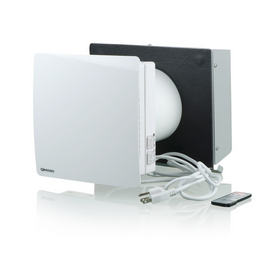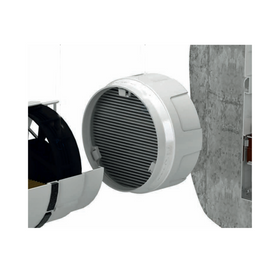- Home

Most HRV and ERV systems use ducts to bring the exhaust air to the central heat-exchange unit and send the fresh air back through the building. They also have separate vents to bring in fresh outside air and send out stale exhaust air. That's a lot of ducts!
What if you don't have room for all those ducts or don't want them? There is a solution – the ductless heat recovery ventilator.
What Is A Ductless HRV or ERV?
A ductless HRV (Heat Recovery Ventilator) or ERV (Energy Recovery Ventilator) is a ventilation system that provides fresh air to your home without the need for an extensive ductwork system. These units work by exchanging stale indoor air with fresh outdoor air while recovering heat (in the case of HRVs) or both heat and moisture (in the case of ERVs) from the outgoing air. This process helps maintain indoor air quality and energy efficiency in homes, particularly in spaces where installing traditional ductwork is impractical.
What Are Use Cases for Ductless Energy Recovery and Heat Recovery Ventilators?
Ductless Energy Recovery Ventilators (ERVs) and Heat Recovery Ventilators (HRVs) are versatile solutions that provide efficient ventilation while maintaining energy efficiency. Below are some specific use cases where these systems shine:
1. Urban Living
In densely populated urban areas, space can be limited, and installing traditional ductwork is often impractical or impossible. Ductless ERVs and HRVs are ideal for apartments, condos, and high-rise buildings where adding full HVAC ducting isn’t an option. These systems require minimal space and allow urban dwellers to maintain indoor air quality without sacrificing energy efficiency.
2. Retrofitting Older Homes
Older homes often lack proper ventilation, especially those built before modern energy codes were established. Retrofitting these homes with a ductless ERV or HRV system offers an efficient way to introduce controlled, balanced ventilation without the hassle and cost of extensive renovations. These units can be easily installed in existing walls or ceilings, providing an energy-efficient way to improve indoor air quality while reducing moisture and humidity issues commonly found in older homes.
3. Small Commercial Spaces
Ductless ERVs and HRVs are not just for residential use; they are also highly beneficial in small commercial environments like offices, shops, and classrooms. In spaces where air quality is essential for comfort and productivity, these systems help maintain a constant flow of fresh air while minimizing energy consumption. Schools, in particular, benefit from the balanced ventilation provided by these systems, which can help create a healthier learning environment by reducing airborne contaminants.
4. Passive and Net-Zero Homes
For homeowners looking to build or retrofit their homes to meet passive house or net-zero standards, ductless ERVs and HRVs are key components in achieving optimal energy performance. These systems are designed to recover heat or energy from the air being ventilated out, making them essential in homes that prioritize energy conservation and sustainability.
By providing flexible, energy-efficient solutions for ventilation, ductless ERVs and HRVs serve a wide range of needs across different living environments, from modern urban apartments to energy-conscious passive homes.
If your home needs ventilation, a ductless HRV could be an excellent choice for you, especially if you have limited space to install ducts. Apart from the energy savings they offer, ductless HRVs are designed to fit inconspicuously into your home, with their low profile and quiet operation. A great example of this is the container cottage that we featured previously on Rise. In a house made of containers, there was not much space for ducts in the rooms. The architect chose to go with ductless HRVs, and they love the results.















